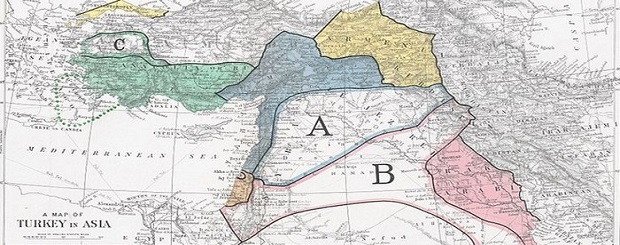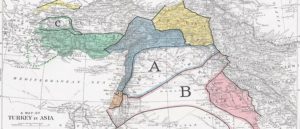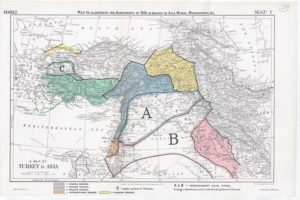
Art-A-Tsolum – The Secret Sykes-Picot Agreement – The Dismemberment of the Ottoman Empire
March 11, 2019 – History: Art-A-Tsolum – PREVIOUS ARTICLE:
On March 9, 1916, England and France received Russia’s consent to the division of the Ottoman Empire. Kept secret from the Arab sheikhs, this agreement was concluded between Britain and France.
The draft agreement was prepared by British diplomat Mark Sykes and his colleague, the former French consul in Beirut Francois Georges-Picot, hence the name of the agreement. The agreement was signed by British Foreign Minister Edward Grey and French Ambassador Paul Cambon in London on May 16, 1916.
In 1915, during WWI and in the period preceding the signing of the agreement, as a result of the Anglo-French-Russian negotiations, England and France demanded that Russia recognize their claims against the Arab countries as compensation for the straits and Constantinople.
In order to resolve the contradictions around the division of Arab lands, the United Kingdom and France began new negotiations in November 1915 and came to an agreement on the issue of division.
When the Russians seized Mush on February 2, 1916, Erzurum on February 3, and on February 7 took Bitlis and approached Mesopotamia, the Allies hurried to inform the Russian Minister of Foreign Affairs Sazonov about the agreement they had concluded.
Sazonov expressed his dissatisfaction with the fact that the UK and France would gain possession of a significant part of the Ottoman territories as a result of this agreement. However, Russia was mainly interested in the straits and Constantinople.
It should be noted that the concepts “Armenia” and “Armenian question” were missing from the document. Although the Anglo-French side recognized Western Armenia as Russian, in a letter to the British ambassador to Russia Buchanan dated March 12, 1916, the representative of the British government Mark Sykes considered not only the creation of an Armenian state but also the surrender of the Armenian lands to Russia impossible.
After trilateral negotiations, the Allies received Russia’s consent to the division of the Ottoman Empire. On May 16, 1916, the secret agreement was concluded, according to which:
1. The rights of Russia to the straits and Constantinople were recognized, as well as to the most part of Western Armenia: Erzurum, Trabezund, Bitlis, Van (including the Hakar region). These regions are colored yellow on the map below.
2. Cilicia, Lesser Armenia, and the Arab lands were to be divided between Great Britain (red zone) and France (blue zone). Zones “A” and “B” were recognized respectively as zones of influence of Great Britain and France.

A few months later, a green zone (southwest of Western Armenia) and a zone “C” (central part of Anatolia) appeared on the Ottoman map. These were to be transferred to Italy which had split off from Germany and joined the Allies.
The Allies declared the Ottoman Empire divided on January 10, 1917. After the February Revolution in Russia in 1917 and the formation of the government of Prince Lvov (March 2, 1917), western leaders began to talk about the division of the Ottoman Empire more clearly and openly.
In the spring of 1917, the Ottoman Empire lost its strategic role as a barrier between Russia and Western Asia and as Russia’s opportunity to get into “warm waters.” US President Woodrow Wilson and British Prime Minister David Lloyd George remarked that “the fall of tsarism drastically changed the eastern wrinkle, and the Russian threat disappeared.” Consequently, the Turkish empire was no longer needed by anyone and was to be destroyed.
On October 25, 1917, the Bolsheviks overthrew the government lawfully created in Petrograd. At the end of November 1917, the Soviet government published the text of the Sykes-Picot Agreement and declared it void.
At the same time, Lenin called on the Russian troops who had fortified themselves on the victorious frontiers to return home. There was a real threat of the capture of Western Armenia by Turkish troops.
In the face of a new balance of power, the agreement was revised in favor of the UK and was used as the basis for future negotiations.
Arshaluis Zurabyan

Sykes-Picot Division. Note: It is known that Saida (present Sidon in Lebanon) was wrongly marked on the location of Sur (present Tyre, just north of the brown area of Palestine). The correct location of Saida is north of the R. Litany. The Litani River thus flows between the two towns. See p. 12 of the 2nd source. wikipedia.org
//allinnet.info/history/the-secret-sykes-picot-agreement/
